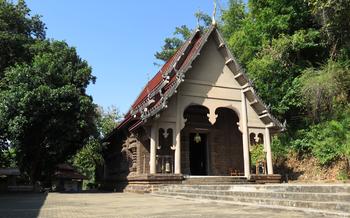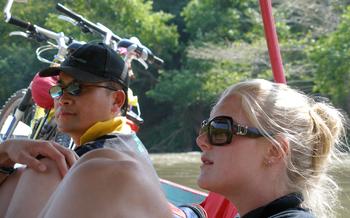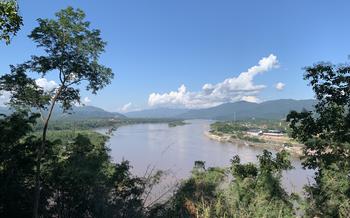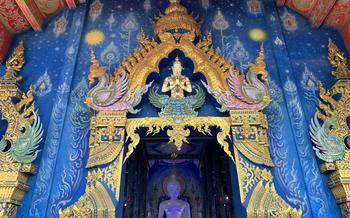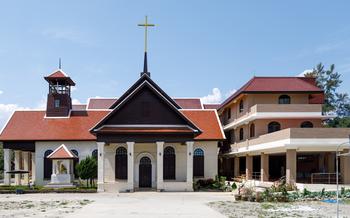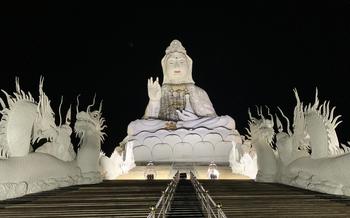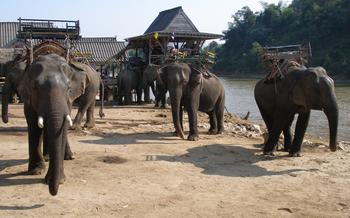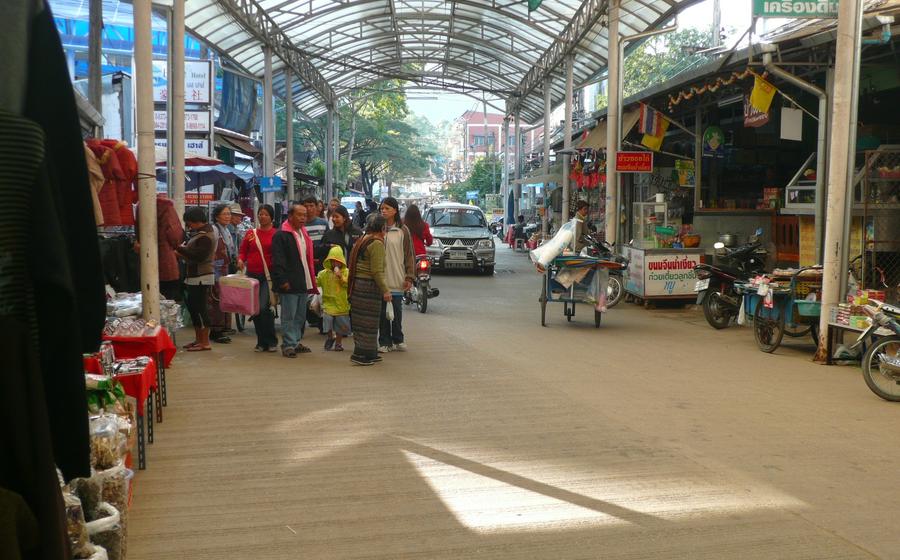
Mae Sai Market
- Mae Sai Market: A Vibrant Cross-Border Marketplace
- Exploring the Thai-Myanmar Border
- Unique Handicrafts and Local Products
- Gems and Jewelry Paradise
- Exotic Food Delights
- Bargaining 101
- Authentic Cultural Souvenirs
- Visiting Nearby Temples
- The Bustling Border Atmosphere
- Day Trip from Chiang Rai
- Hill Tribe Villages in the Area
- Responsible Tourism Practices
- Off-the-Beaten-Path Discoveries
- Avoiding Tourist Traps and Scams
- Insider Tip: Enhancing Your Market Experience
Mae Sai Market: A Vibrant Cross-Border Marketplace
The Mae Sai Market, nestled on the northernmost tip of Thailand, bordering Myanmar, is a bustling cross-border marketplace that has captivated traders and travelers for centuries. Steeped in history and cultural significance, the market has evolved into a vibrant melting pot where Thai and Myanmar traditions harmoniously intertwine.
Located just a stone's throw from the Friendship Bridge, which connects Thailand to Myanmar, the market is easily accessible by road or public transportation from Chiang Rai, the provincial capital. As you approach the market, the air fills with a heady mix of spices, exotic fragrances, and the lively hum of human interactions.
The market's vast expanse is a labyrinth of stalls, each showcasing unique treasures. From colorful textiles and intricate handicrafts to fresh produce and exotic snacks, the Mae Sai Market offers an overwhelming array of goods that cater to every taste and budget.
To navigate the market efficiently, it's best to start by exploring the main aisles and gradually venturing into the smaller alleys and hidden corners where hidden gems often await. Remember to embrace the local customs and bargaining culture as you interact with the friendly vendors who are always willing to strike a deal.
Exploring the Thai-Myanmar Border
The Mae Sai Market sits at the heart of a vibrant cross-border region where Thailand and Myanmar converge. This unique location has shaped the market's character, making it a melting pot of cultures, traditions, and influences from both countries.
Thai and Myanmar traders have been interacting and exchanging goods in this border region for centuries. The market serves as a crucial hub for trade and commerce, with locals and tourists alike flocking to buy and sell a diverse range of products. This vibrant exchange has created a fascinating blend of cultures, visible in the market's architecture, cuisine, and the interactions between the people.
Visitors to the market can witness the seamless fusion of Thai and Myanmar cultures. The market stalls are adorned with colorful textiles and traditional handicrafts, showcasing the unique artistic expressions of both countries. The air is filled with the aroma of delicious street food, as vendors from both sides of the border offer their culinary delights, creating a tantalizing blend of flavors.
The border region is also an excellent place to observe and experience the dynamics of cross-border trade. Traders from both countries engage in lively negotiations, often using a mixture of languages and gestures to bridge the communication gap. The market provides a glimpse into the intricate relationships and interactions that take place between these two neighboring countries, creating a vibrant and captivating atmosphere.
Whether you're a seasoned traveler or a curious explorer, the Mae Sai Market offers a unique opportunity to immerse yourself in the vibrant cross-cultural tapestry of the Thai-Myanmar border region. Embrace the energy, explore the diverse offerings, and let the market's unique atmosphere transport you to a world where cultures intertwine and traditions blend seamlessly.
Unique Handicrafts and Local Products
The Mae Sai Market is a haven for those seeking unique handicrafts, textiles, and accessories. Local artisans display their creations, ranging from intricate silver jewelry to colorful hand-woven scarves. Visitors can find an array of traditional Thai crafts, including ceramic pottery, bamboo products, and intricate wood carvings that reflect the region's rich cultural heritage.
In addition to handicrafts, the market offers an abundance of local agricultural products, fresh fruits, and delectable snacks. Visitors can savor the sweet taste of ripe mangoes, indulge in the spicy kick of chili paste, or try exotic fruits like dragon fruit and rambutans. Bargaining is an essential part of the market experience, and visitors can engage in friendly negotiations with vendors to secure the best prices. By supporting local artisans and purchasing their products, travelers contribute directly to the community's economic development and cultural preservation.
Gems and Jewelry Paradise
Mae Sai Market is renowned for its vast selection of precious stones and jewelry, attracting gemstone enthusiasts and collectors from around the world. The market is a treasure trove of rubies, sapphires, emeralds, and other sparkling gems, sourced from the mines of Myanmar and Thailand. Visitors can find a wide variety of jewelry designs, from traditional to contemporary, crafted by skilled local artisans.
When shopping for gems and jewelry at Mae Sai Market, it's essential to have a discerning eye and some knowledge about gemstones. Look for stones with good clarity, color, and cut. Be wary of imitations and treated stones, and ask for certificates of authenticity from reputable sellers.
For those interested in creating custom jewelry pieces, Mae Sai Market offers a unique opportunity. Skilled craftsmen can create one-of-a-kind designs using the gems of your choice, ensuring a truly personalized souvenir of your visit.
Exotic Food Delights
The Mae Sai Market is not just a haven for shopping; it's also a culinary paradise. Indulge your taste buds with a symphony of flavors as you explore the vibrant street food stalls and local delicacies. From the aromatic Khao Soi, a rich and creamy coconut-based noodle soup, to the succulent Sai Oua, a spicy grilled sausage, the market offers a tantalizing array of dishes that will delight your palate. Don't miss the legendary Mango Sticky Rice, a sweet and sticky treat that perfectly balances the flavors of ripe mango and glutinous rice. For those with dietary restrictions, vegetarian and vegan options are readily available, ensuring that everyone can partake in the culinary adventure. As you savor the diverse flavors, remember to strike a balance between the fiery spices and your taste buds. Embrace the culinary journey and let your taste buds dance to the rhythm of Thai cuisine.
Bargaining 101
Bargaining is an integral part of the shopping experience at Mae Sai Market. It is a cultural tradition that allows buyers and sellers to interact and negotiate prices. To successfully navigate the art of bargaining, it's essential to understand the etiquette and strategies involved.
-
Cultural Etiquette: Bargaining in Thailand is generally expected and seen as a way to show respect for the seller's livelihood. It is considered impolite to offer the full asking price without attempting to bargain.
-
Starting Prices: Many vendors set their initial prices higher, assuming that customers will bargain. Be prepared to start your offer at 50-75% of the asking price and gradually increase it as needed.
-
Body Language: Nonverbal cues play a significant role in bargaining. Maintain eye contact, smile, and be friendly, but avoid showing too much eagerness.
-
Communication: Be polite and respectful in your interactions with vendors. A friendly demeanor and a few words of Thai can go a long way in building rapport and getting a better deal.
-
Acceptable Range: Most vendors are willing to negotiate within a reasonable range. Don't be afraid to walk away if the price is too high, as there are often other vendors selling similar items.
Authentic Cultural Souvenirs
The Mae Sai Market is not just about gemstones and food; it's also a treasure trove of authentic cultural souvenirs representing the diverse traditions of Thailand and the surrounding hill tribes. From intricate handmade pottery to finely carved wooden figurines and colorful woven textiles, the market offers a glimpse into the rich cultural heritage of the region.
One of the highlights is the collection of handmade pottery from the nearby Ban Pa Pong Piang village, known for its unique black ceramics. These beautiful pieces, crafted using traditional techniques, are both decorative and functional, adding a touch of elegance to any home.
For those seeking unique textiles, the market offers a stunning array of handwoven fabrics, scarves, and clothing from various hill tribes, including the Akha, Hmong, and Lisu. Each tribe has its distinctive style and patterns, reflecting their cultural identity and beliefs.
In addition to pottery and textiles, the market also features a variety of other handcrafted items, such as intricate silver jewelry, bamboo products, and traditional musical instruments. These souvenirs are not only beautiful but also provide a meaningful way to support local artisans and the preservation of cultural traditions.
When shopping for cultural souvenirs at the Mae Sai Market, it's important to remember that these items are often handmade, and each piece is unique. Take the time to appreciate the craftsmanship and the story behind each item, and support the local communities by purchasing directly from the artisans. By doing so, you not only take home a piece of Thailand's cultural heritage but also contribute to the preservation of these valuable traditions.
Visiting Nearby Temples
In addition to the vibrant market, Mae Sai boasts several historic temples within walking distance, offering a glimpse into the town's rich cultural and religious heritage. These temples showcase stunning architectural designs, intricate carvings, and significant religious relics. One notable temple is Wat Phra That Doi Wao, situated on a hilltop overlooking the town. This temple features a gleaming white chedi and offers panoramic views of the surrounding landscapes. Another must-visit temple is Wat Tham Pla, known for its cave shrine housing numerous Buddha images and stalactite formations.
When visiting these temples, it's essential to dress respectfully, covering your shoulders and knees. Remember to remove your shoes before entering the temple grounds and maintain a quiet and reverent demeanor. Take your time to admire the intricate details and craftsmanship of the temples, and soak in the tranquil atmosphere. Combining cultural exploration with shopping allows for a well-rounded experience in Mae Sai, providing a deeper understanding of the town's diverse heritage and traditions.
The Bustling Border Atmosphere
The Mae Sai Market is not just a marketplace for buying and selling goods; it is also a place where cultures converge and traditions intertwine. Locals and tourists from both Thailand and Myanmar mingle in the vibrant alleys, creating a lively and bustling atmosphere. Observing this cross-cultural exchange is an experience in itself. Vendors call out to customers in a mix of Thai and Burmese, creating a symphony of sounds that fills the air. The market is a testament to the harmonious coexistence of different cultures, where people from both sides of the border come together to trade, socialize, and share their unique traditions. Capturing the essence of this border town's energy is a must-do for any traveler seeking an authentic cultural experience.
Day Trip from Chiang Rai
Mae Sai Market is conveniently located just a short distance from Chiang Rai, making it an ideal day trip destination. Transportation options are plentiful and affordable, with both public buses and private tours available. Public buses depart from Chiang Rai's main bus station and take approximately 5 hours to reach Mae Sai. Alternatively, guided tours from Chiang Rai typically include round-trip transportation, as well as visits to other attractions in the area, such as temples, hill tribe villages, or hot springs.
If you choose to explore independently, it's advisable to plan your day trip itinerary carefully. Start early to make the most of your time, as the market is busiest in the morning. Allow ample time for browsing, shopping, and bargaining, as well as for lunch and exploring the nearby temples. You can combine Mae Sai with other attractions nearby, such as the Golden Triangle, the Hall of Opium, or the Elephant Sanctuary.
Hill Tribe Villages in the Area
Beyond the bustling market, the Mae Sai region is home to a diverse array of hill tribe villages, each with its unique traditions, handicrafts, and textiles. A visit to these communities offers an immersive cultural experience and a chance to support local artisans and their way of life.
The Akha, Lisu, Lahu, and Karen tribes are just a few of the ethnic groups that call this region home. Each tribe has its own distinct language, customs, and dress, creating a rich tapestry of cultural diversity. Visitors can explore these villages, interact with the locals, and gain insights into their daily lives and traditions.
Homestays are a popular way to experience hill tribe culture firsthand. Staying with a local family allows visitors to immerse themselves in the community, learn about traditional practices, and enjoy authentic home-cooked meals.
When visiting hill tribe villages, it is important to be respectful of local customs and traditions. Dress modestly, ask permission before taking photos, and avoid bargaining aggressively. By following these guidelines, visitors can contribute to the preservation of these unique cultures while supporting the local economy.
Responsible Tourism Practices
As you explore the Mae Sai Market, it is essential to be mindful of responsible tourism practices. This includes supporting ethical and sustainable shopping practices. Avoid purchasing products made from endangered species or that contribute to environmental degradation. Respect local customs and bargaining etiquette, and always be polite and courteous to vendors. Look for opportunities to support fair trade and community development initiatives, such as buying directly from local artisans or participating in community-based tourism programs. By embracing responsible tourism, you can help preserve the unique cultural heritage of the Mae Sai Market and ensure that it remains a vibrant and sustainable marketplace for generations to come.
Off-the-Beaten-Path Discoveries
Beyond the main market area, adventurous travelers can venture into the hidden gems and lesser-known sections of the Mae Sai Market. This is where one can truly experience the authentic charm and uniqueness of the place. Explore the back alleys and side streets to discover hidden stalls and shops showcasing unique souvenirs and local specialties. Interact with friendly locals and vendors who are more than happy to share stories and insights about their products. By stepping off the beaten path, you'll create a personalized market experience that goes beyond the usual tourist trail.
Avoiding Tourist Traps and Scams
Navigating the Mae Sai Market requires a keen eye for authenticity and a healthy dose of caution. While the market is generally safe and welcoming, it's essential to be aware of potential tourist traps and scams. One common tactic is inflated prices aimed at unsuspecting tourists. To avoid falling prey to this, research typical prices for items before you start shopping. If a vendor's price seems unreasonably high, politely decline and move on. Another common scam involves fake gemstones or jewelry. To ensure you're getting the real deal, only purchase from reputable vendors who provide certificates of authenticity. Trust your instincts, and if a deal seems too good to be true, it probably is. Ask for recommendations from your hotel concierge or local guides to find trustworthy vendors. Finally, be vigilant about your belongings, as petty theft can occur in crowded marketplaces. Keep your valuables close and avoid carrying large amounts of cash.
Insider Tip: Enhancing Your Market Experience
To fully immerse yourself in the vibrant atmosphere of Mae Sai Market, consider arriving early in the morning before the crowds descend. This allows you to leisurely browse the stalls, engage with vendors, and find unique treasures without feeling rushed. Additionally, wear comfortable shoes as you'll be doing a lot of walking and bargaining.
Carrying small denominations of Thai Baht is essential for easy transactions and bargaining. The market primarily operates on cash, so having the right currency on hand will save you time and hassle. Remember to stay hydrated, especially in the warm Thai climate. Take breaks to rest, savor the local delicacies, and soak in the lively ambiance of the market.
